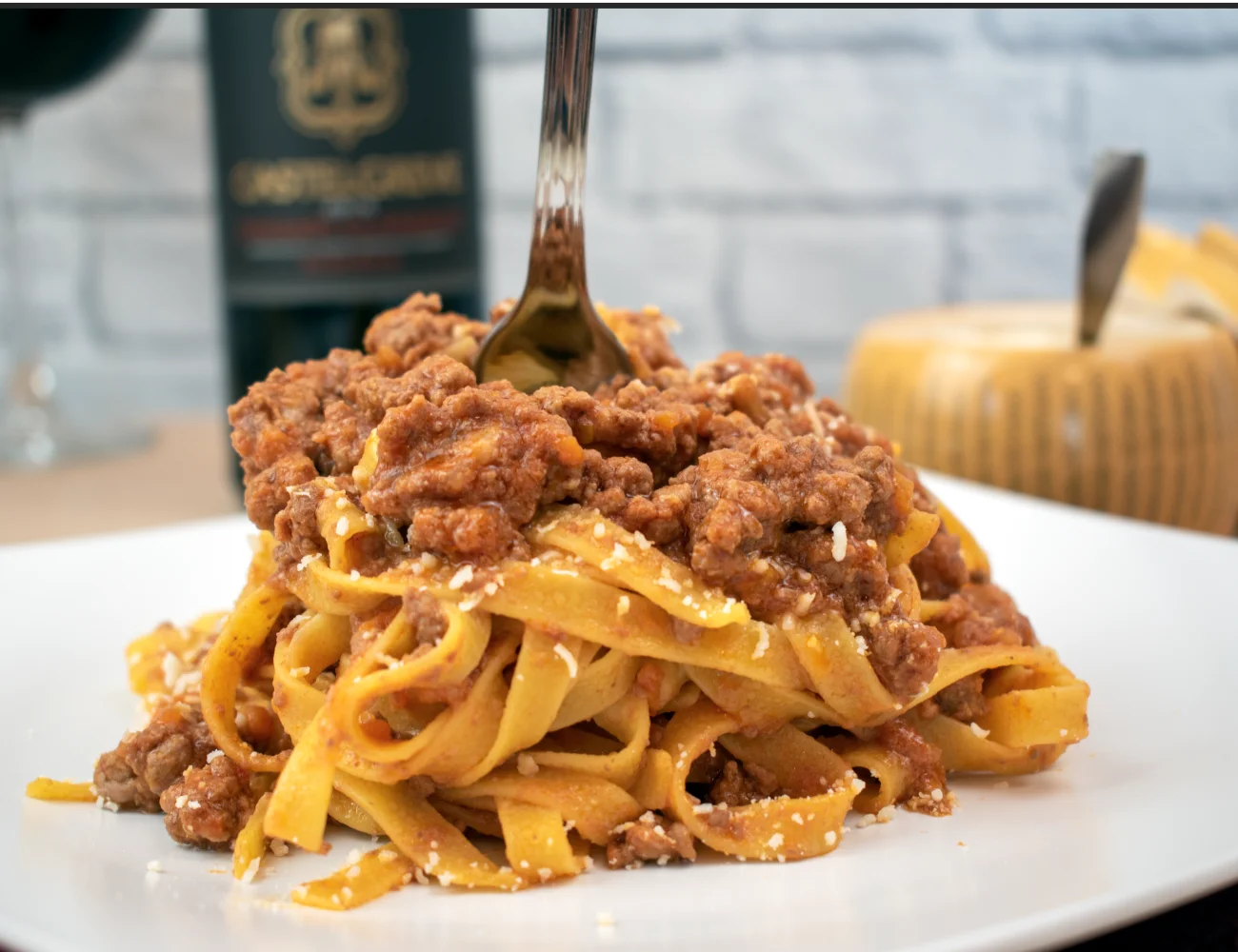Fresh tagliatelle pasta is the pasta of choice in Italy for many famous Italian sauces, including Ragù Bolognese! To learn how to make fresh tagliatelle pasta from scratch at home like an Italian, keep reading!

Watch the Video Recipe!
Nonna Lulu makes fresh pasta dough, then cuts it into fresh tagliatelle!
Subscribe to our YouTube Channel
More video recipes? Subscribe to our YouTube Channel (it’s FREE) and click the bell to get notifications when we release a new video recipe!
How to Make Fresh Tagliatelle Pasta: Tips
Start with 3/4 the flour. Add more if needed.
The biggest mistake you can make with fresh pasta is adding too much flour. It’s best to start with 3/4 of the flour recommended and add more as needed to achieve a smooth, elastic dough ball.
Pasta too dry? Try this!
If you don’t follow the tip above and end up with pasta that is too dry to stretch, you can add a few drops of water or olive oil to add some moisture. Though many pros wouldn’t recommend this, home chefs do this when needed and the result can still be tasty.
How to Store Tagliatelle
To freeze tagliatelle, roll each portion of pasta loosely around your hand to create a ‘nest.’ Spread the portions out on a flat, lightly-floured board. Do not overlap the portions of pasta. Let the tagliatelle freeze flat on the board for a few hours. Once frozen, they can be safely be transferred to freezer bags.
Or, Make Fresh Spinach Tagliatelle Pasta!
Check out our recipe for making fresh spinach pasta dough. Then, stretch it and cut it as described in this recipe to make spinach tagliatelle!
Traditional Sauces to Serve with Fresh Tagliatelle Pasta
Tagliatelle is the pasta of choice for a number of authentic Italian pasta sauce recipes—for example, Ragù alla Bolognese and Tagliatelle ai Funghi (Mushroom Pasta).
There’s also the famous ‘Straw and Hay’ pasta with green and regular tagliatelle—coming soon to our website.
As an Amazon Associate, we earn from qualifying purchases. This means at no extra cost to you, PIATTO may earn a small commission if you click the links and make a qualifying purchase.
Fresh Tagliatelle Pasta Recipe
Equipment
- 1 Rolling Pin or Pasta Machine for stretching the pasta
- 1 large knife or pasta cutting extension
Ingredients
- 7 oz pasta flour alternatives: all-purpose or '00'
- 7 oz semolina flour "semola grano duro rimacinata"; or look for semolina flour for pasta.
- 4 whole eggs whole
- 1 pinch fine salt (optional)
Instructions
Make the Pasta
- Mix the flours together in a pile on a work surface. Make a well in the center of the flour. Add the whole eggs to the center of the flour. Add the salt (optional).Begin to beat the flour into the eggs with a fork, pulling the flour in from the sides a little at a time.7 oz pasta flour, 7 oz semolina flour, 1 pinch fine salt, 4 whole eggs
- Using a stand mixer? Start with ¾ of the flour recommended and add more flour as needed. It’s better to start with too little flour than too much.
- When the dough begins to look shaggy, compress the dough into a loose ball and begin to knead. Knead the dough until it is smooth and elastic. When you push in on the dough, it should spring back.
- When the fresh pasta dough is ready, cover and let the dough rest for at least 30 minutes.
Stretch and Cut the Pasta
- Work with ¼ of the dough at a time. Keep those pieces you aren't working on covered or wrapped in plastic. This will prevent the pasta from drying out.
- Place ¼ of the dough on a well-floured surface. Flour both sides of the dough. Roll or press the dough into a ¼ inch (½ cm) thick rectangle.
- Pass the floured rectangle through a pasta roller, starting at the widest setting. Feed dough into machine short-side first. Then, place the dough lengthwise on the floured work surface. Fold the dough as you would a letter, starting with one side. Roll out the dough again till it is ¼ in (½ cm) thick.
- The short side of folded dough rectangle should be a little smaller than the width of your pasta roller. Then, pass the pasta through the roller again.Reduce the width of the pasta roller one setting. Pass the pasta through the roller again. Always feed the pasta in short-side firstPass the pasta through the roller, each time reducing the roller width one setting. The final thickness of the pasta dough for tagliatelle should be less than a millimeter in thickness (.6 – .8 mm).
- Generously flour the stretched pasta on both sides. Roll the pasta into a tight, flat roll that is 1 1/2” (4 cm) in diameter. With a sharp knife, cut the pasta into 1/4 inch (6 mm) strips.
- Or, pass the stretched dough through an appropriately-sized pasta cutter. Separate the cut tagliatelle into portions and sprinkle with more flour to prevent sticking.
Cook the Tagliatelle Pasta
- Boil the fresh tagliatelle in salted water for 2-3 minutes. The longer the pasta dries, the longer you’ll need to cook it to re-hydrate it. Cook until the tagliatelle until it is al dente—this means it is cooked, but still has a bit of a bite!

